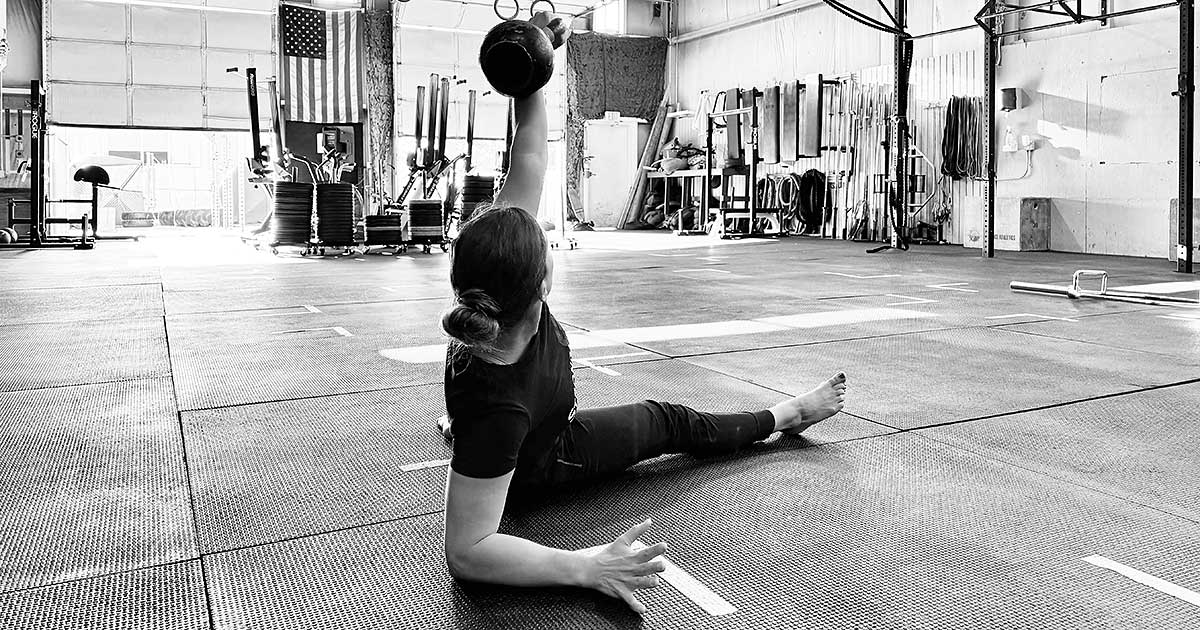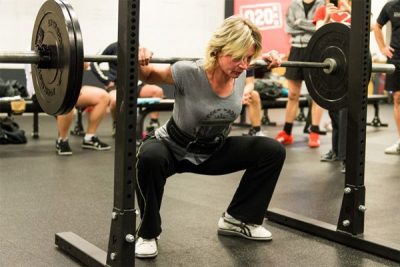
In our StrongFirst system, there are many “a-ha” or “what the heck” moments that are identified as carryover effects. These carryovers translate into unexpected strength gains, better movement, and endurance in other lifts you haven’t specifically been training. This is an exciting part of the training process, when your lifts become easier, and you find yourself setting personal bests without even psyching up for them.
In this article, I will cover three specific movements that gave me “what the heck” moments and helped me gain strength in my kettlebell military press without specifically training it. If you are struggling to get past that sticking point in the military press or are looking for ways to increase your press without pressing, this article is for you.
First, let’s begin with the basics of the press.
Pressing Basics
At our SFG Certifications, students are taught how to press from the top down. It is a gradual build to get to the full execution of the strict press. First, we set the foundation of the deadlift and explain how the deadlift leads to a strong, safe, and powerful swing. Then, we learn how the swing sets the base for the clean. And finally, we see how a properly performed clean sets up a solid base for a perfect press.
Also key is the timing of the breath. We utilize the power breathing with the press, breathing behind the shield of tensed abdominals, inhaling as we pull the kettlebell down, and emitting a sharp exhale as the kettlebell passes the head. With a true maximum effort on a press, holding the breath through the execution of the clean when the kettlebell passes the head will ensure there is maximum tension and less chance of leaking strength when the clean comes into the rack. (This is not recommended for students with heart problems or high blood pressure.)
Hand and wrist position play an important role in the press. The press is a grind, as opposed to the ballistic explosiveness of the swing or jerk. Grinds are performed with the handle of the kettlebell sitting in a diagonal position in the hand. Pavel taught us there are three neuromuscular generators in the body that will improve strength: the abs, glutes, and grip. The grip, activated when grinding through a sticking point, will provide irradiation to all the surrounding muscles to help complete the press. Specifically squeezing the pinky will help fire the triceps to push the kettlebell to lockout. The wrist, slightly goose necked, will be in a stronger position for your heavy press because it will keep the kettlebell from peeling away from you on the ascent.

Now that we know the pressing basics, let’s move on to how we can increase our press, without pressing.
Multiple Get-ups
It is no secret that get-ups will improve your overhead mobility and stability, or that a steady diet of get-ups can help your pressing strength. What I hadn’t experienced until my coach, Karen Smith, StrongFirst Certified Master Instructor, programmed them in for me was how stringing several get-ups together at a time would put my pressing strength in hyper drive.
I’ve had solid strength gains from sets of ten alternating get-ups, as well as doing two in a row on each side. But as we’ve learned, sets of five are great for strength gains. So, when I started performing sets of five unbroken get-ups on each side, some magic started to happen.

Over the course of six weeks, I went from 12kg to 20kg in my sets of five. I’d like to tell you doing five get-ups in a row is enjoyable—but like Pavel says, “Enjoy the pain.’” The reward, though, is pretty sweet.
Snatch Volume
A big player in improving my overall pressing strength was the snatch. I pushed the volume up with a kettlebell one and two times heavier than my standard snatch kettlebell (16kg) and progressively worked to shave time off completing my programmed number of lifts. Once a week, I completed the Secret Service Snatch Test (as many reps as possible in ten minutes) with the 12kg (one kettlebell down from my target snatch-sized kettlebell) and heavy one-arm swings, which undoubtedly improved my grip strength.

My program also included the SFG snatch test (100 reps in five minutes), but my job was to complete it with a kettlebell heavier than 16kg and work on doing it in less time each week. Performing explosive, over-speed multiple-rep snatches once a week with a lighter kettlebell helped make the heavier kettlebell feel lighter in my practice with snatches and presses.
The progression I made was impressive to log. Each week, I was doing more work in less time, except for one week that I had not rested and recovered enough. Looking back through my training, I noticed a pattern of improved times. I also noted how good the sets and reps felt in my training log, whether it was “strong,” “struggled,” or “tired.” While there was week to week variability depending on my stress, sleep, and hunger levels, there was also a steady upward progression.

Single-leg Deadlifts
Single-leg deadlifts have become one of my training staples, and I continue to find areas where this exercise benefits other lifts. The single-leg deadlift is taught at the SFB, our bodyweight instructor certification. Karen Smith programmed these into my Iron Maiden training to save my back from too many pistols after I had suffered a disc herniation.
Karen wrote about how to perform the single-leg deadlift in her article, “The Single-leg Deadlift: The Most Underutilized and Powerful Skill” and the carryover from the single-leg deadlift to the one-arm pushup is covered in this article, “Unlocking the One-arm Pushup.”
Single-leg deadlifts teach you how to “press” into the floor and load your feet. Rooting, wedging, and pushing through the floor is necessary to perform the press. A heavy press requires tension, zipping up, and driving through the floor with your feet. The single-leg deadlift teaches you to how to wedge and push yourself down into the ground away from the kettlebell because you must push into the ground as you move from the hinge to the standing position.
Trunk strength will improve with your single-leg deadlift training as well. To perform the movement correctly, you need to brace your abs and breathe behind the shield (imagine bracing for a punch from a pesky little brother). You must keep your shoulders stacked over level hips as you move through the hinge. Keeping your hips level and engaging your glutes is also important in the press, as squeezing the glutes is one of the three ways to generate more tension and power.

All your side muscles, including the lats, pecs, biceps, delts, and triceps play an important role in the single-leg deadlift and press. The lats can be engaged by poking your finger into your armpit and trying to pinch and squeeze down on it or by imagining resisting someone trying to tickle under your arm. Once the lats are engaged your trunk is tightened and stabilized to perform the single-leg deadlift. Pressing down with the lats, tensing the delts, and squeezing the triceps keeps the kettlebell in the proper groove for the hinge in the single-leg deadlift and in the press. This “zipping up” required on the side for the single-leg deadlift directly carries over to pressing strength.
My “a-ha” moment came after performing a set of heavy single-leg deadlifts. The wedging, driving with my foot, and cramping down of the lats, delts, and side muscles was still fresh in my muscle memory when I cleaned a 24kg kettlebell and did an easy press, previously my one-rep max six weeks prior. I ended up with three sets of three right and three left with the 24kg, blowing away any pressing bests I had in the past.
Using Your Carryover Strength Effectively
In May 2014, I attended a Strength Seminar presented by Andy Bolton and Pavel. One of the most intriguing facts (there were many) I took from the weekend was that Andy Bolton, the first man to deadlift over a thousand pounds, never trained with more than 750 pounds leading up to his historic lift.
This taught me an important lesson. Your training will suffer if you try to set a personal best each and every session, in between sessions, or on your rest days just playing around. I learned this to be true during my Iron Maiden training, and never did a weighted pullup heavier than 16kg in my last eight weeks of training leading up to my successful completion of the challenge. I only did my presses when my program called for it, once per week. I had steadily progressed up to solid sets of five on my pressing with the 22kg and felt like I still had gas in the tank after finishing my sets.
A Page from My Training Log
Here is an example of how I incorporated these three movements into my program. My max kettlebell military press at this time was 26kg.




Effectively Managing the Strength Gains
It is clear that get-ups, snatches, and single-leg deadlifts helped me plug up strength leakages which translated into stronger pressing. Of course, you need to practice the pressing basics as well (covered earlier). Use a light weight until you have mastered the concept of pushing your body away from the kettlebell and using your entire body as one unit to press. Practicing the StrongFirst plank and hollow holds will teach your body how to do this. Make sure to have your technique looked at by a qualified SFG Instructor, who can identify if your set up and breathing are helping you maximize and connect your strength. Keep a log of your training and note any consistent drops in progress. This is a sign to back off on the volume and take some extra rest. Finally, add in sets of nonstop get-ups, throw in some heavy snatches, increase the volume of light snatches, incorporate some heavy single-leg deadlifts, and watch your personal records grow.









